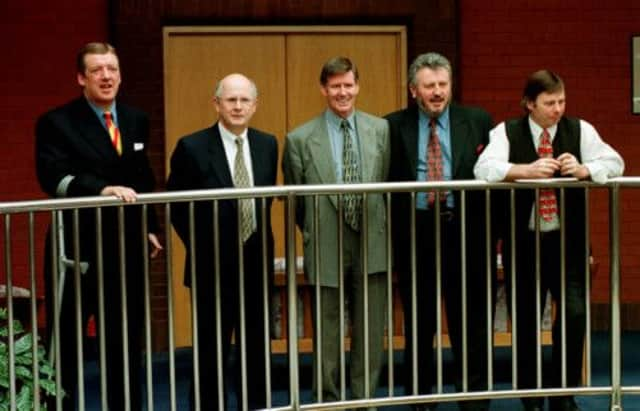Glenn Gibbons: Risible SPL reconstruction saga


Culpability in this affair is the exclusive preserve of the architects of the SPL, Fergus McCann and David Murray, and the ovine chairmen of the other eight clubs who followed them meekly on a course of action that was born of nothing other than scandalous self-interest.
The secession of the ten from the Scottish Football League in 1998 was driven entirely by the conviction of the owners of Celtic and Rangers respectively that the day would soon dawn when they would be able to negotiate their own television contracts. Astonishingly, they managed to persuade the others that they would be “left behind” if they did not run away to this particularly gruesome circus.
Advertisement
Hide AdAdvertisement
Hide AdIt is the ultimate irony of the risible attempts at reform in recent years that one of the main planks on which change should be built – this has been proposed by all manner of people, from Henry McLeish to the overwhelming majority of fans who bombard websites and forum with their views – should be the introduction of a single governing body.
Far from innovation, of course, this would simply be reversion to the set-up that existed for 108 years from the inception of the Scottish Football League in 1890 to the now infamous split in the last days of the twentieth century. Incidentally, those who clamour for an amalgamation of all three current administrative and legislative organisations are doomed to frustration. Neither the Scottish FA nor the League (in whatever form the latter eventually assumes) would benefit from a union. Among innumerable reasons for eschewing such a mating, one of the most persuasive would be the near-certainty that the revenues of the league clubs – in short, the professional game – would be diluted by being more thinly spread, the result of the national association’s obligation to care for all of its affiliates, from schoolchildren to the Scotland team.
In the statement released by the SFA in midweek, the most striking phrase concerned the association’s commitment to the principle of “a single league body”. Nobody needs to be hawk-eyed to see that this “new” entity will spring solely from the re-connection of the SPL the SFL.
The readiness to embrace re-unification amounts, finally, to an admission of what some of us insisted forcefully in 1998: that there was nothing the dissidents could achieve in their new venture which would have been beyond their reach by remaining under the umbrella of the SFL.
This is not to argue, of course, that Scottish football would have been problem-free had the separation not taken place. But it is reasonable to suggest that the clubs as a whole would have been less impoverished, even if only on the basis of avoiding the enormous costs of their action.
There would have been, for example, only one chief executive (almost certainly the exceptional, now-retired Peter Donald), one board/management committee and unchanged staffing levels on the administration side. In addition, the annual payment made by the defectors to the SFL clubs in order to effect an immediate departure – otherwise known as “the bribe” – was more than the smaller clubs were taking from the existing pot, and there would have been no legally-binding promise to become a 12-team league (thereby necessitating the abominable “split”) by the year 2000.
It has long been this column’s contention, in any case, that no amount of tinkering with numbers or permutations will assist in overcoming the most fundamental trouble of all: the steady, and so far uninterrupted, decline in general playing standards over the past 25 years or so.
This is a blight that is not exclusive to Scotland, but it is one that this country is not well equipped to handle. If the present resurgence in the production of quality players in other small countries such as Wales and Belgium helps to confirm that the phenomenon is cyclical, it also provides dispiriting evidence that the wheel can take decades to complete a revolution.
Advertisement
Hide AdAdvertisement
Hide AdThere is incontrovertible evidence of a similar slump in England, where those whose judgement has not been warped by irrational chauvinism have been anxious for some time about the deterioration in the general standards among players available to the national team.
That the Premier League remains the most lucrative and most viewed in the world game owes much to the presence at many clubs of what may be called the heavy battalions of the International Brigade.
Over the past few years, indeed, there has been weighty evidence to suggest that this waning of excellence has been, with the notable exception of Spain, a pan-European trend. It is no mere coincidence that, apart from Cristiano Ronaldo, the most mesmerising and dangerous attacking players currently at work – that is, football’s A-Listers – are all South American.
Of the most celebrated quartet – Lionel Messi, Sergio Aguero, Carlos Tevez and Luis Suarez – three are Argentine. Those who would be closest behind the Manchester City and Liverpool players in the Premier League would include Robin van Persie and Gareth Bale, one Dutch, the other Welsh. Anyone who prosecutes the case for the inclusion of Wayne Rooney in that company is at risk of being accused of attention deficit over the past few years.
During the current debate over league reconstruction in Scotland, much has been made of the need to canvas the fans for their ideals. These have ranged from a ten-team to an 18-team league and all stations in between. The one area in which there has been unanimity, however, is the lamentation over the erosion of quality players. It is a dilemma that cannot be solved by ballot.